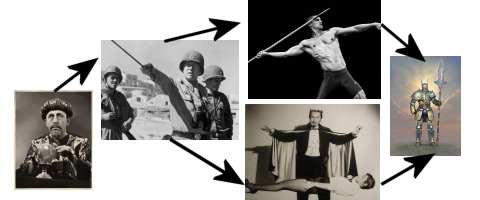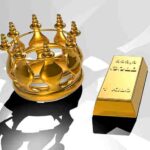Some time ago, I read a book recommended to me by Robert Kittridge of Focus Point Solutions call Barbarians to Bureaucrats written by Lawrence M. Miller in the late 1980s. The book documented the life cycle of a corporation. After internalizing the message, I updated the model to reflect how a small business might evolve and attempted to summarize the message into the following small business evolution cycle.
Most business cultures follow a rather predictable path as the business progresses and grows. In addition to the business culture, the role of a business leader must also develop or the business gets stuck.
Sometimes, the founder adjusts his style or adds partners who have the skills the company needs, other times the business stalls or fails. Throughout the life cycle of a business, the culture and leadership requirements of a company need to continue to develop.
Typical Business Lifecycle
Values and motives change as a business evolves. A business that often begins as a passion project gains momentum and takes an offensive posture to accumulate wealth, and then a more defensive posture to preserve its market position and the owner’s wealth later in life. If there is no second wave, the business often decays until it is either acquired in a fire sale or simply closes its doors. Knowing how a typical business evolution unfolds allows leaders to understand and manage the business evolution process in productive ways.
The following illustration depicts the typical small business evolution from start-up to maturity.
There are four stages of the business evolution. As the business evolves and the culture changes the role of the leader(s) evolves as the company progresses through each of the four distinct business evolution stages.
- Stage 1: The Oracles of Business
- Stage 2: The Generals of Business
- Stage 3: The Athletes and Performers of Business
- Stage 4: The Guardians of Business
Business Evolution Stage 1: The Oracles of Business

Stage 1 encompasses the pre-start-up and early start-up period of a business. Most companies are started by a founder who is essentially the idea person behind the business. I refer to this person as the “Oracle”.
In classical antiquity, an Oracle is a person who can see and predict the future. The Oracle of a business is the charismatic and often eccentric person that plays a major role during stage 1 of the business evolution cycle. They are often ineffective on their own since they are technically focused and often lack the essential business acumen to convert their ideas into a thriving business.
The Oracle is often not motivated by material comforts but tends to be more driven by the idea generation process itself. They like to create a new product or service in response to a recognized problem to contribute to society. In contrast, a business founded with the sole purpose of making money rarely makes any significant contribution to the marketplace.
The most valued attribute of the Oracle is their vision and ability to get others to see it too. Oracles frequently started their careers working for larger corporations where they felt that their creativity was stifled. They often leave corporate life to start their own business because their previous boss would not listen to their ideas.
The Oracles of McDonald’s restaurants were Richard and Maurice McDonald. They had the vision that the car culture was coming and built a drive-in carhop restaurant to serve food quickly. They invented the flat top grill and replaced glasses, napkins, and silverware with paper cups, paper bags, and wrappers. They experimented with menu items and finally settled on nine of their most popular items. All their burgers were topped the same way to decrease the time between orders so they could deliver your meal as fast as possible.
Being idea guys, they got bored when they didn’t see any more ways to improve. They did not have the passion or the skills for expansion. Businesses in stage 1 often have one product or service. Survival is the name of the game for these companies. Many businesses remain stuck at this point since it takes a different type of leader to move past stage 1. Moving from one stage to the next is like changing gears in an automobile with a manual transmission; it requires a conscious effort and you may lose a little momentum during the change.
Business Evolution Stage 2: The Generals of Business

For a business to advance from stage 1 to stage 2, the business requires that the role of the Oracle be supported or replaced by a business development person. I refer to this new leader as the “General.” In our McDonald’s example above, it was a guy by the name of Ray Kroc.
Ray Kroc bought the business from the McDonald brothers and took McDonald’s from stage 1 to stage 2. This cycle repeats itself over and over again for any business that continues to grow and evolve beyond basic survival mode.
Thomas Edison was an Oracle. By himself, Edison invented many things. However, he was not capable of growing his inventions into a really profitable business. Edison didn’t have the desire or skills to take his ideas beyond a stage 1 business evolution and was always looking for funds to continue his research. It took the likes of JP Morgan, a General, to take Edison’s ideas and turn them into the company we know today as GE.
Sometimes, the Oracle acquires the skills of the General, as in the case of Henry Ford and JD Rockefeller. However, this is less common in more modern times.
Frequently, the Oracle and General get paired up early in a company’s lifecycle based on the perceived strengths and weaknesses of the founders. For example, Stephen Wozniak was the Oracle and Steve Jobs was the General for Apple. Bill Hewlett was the Oracle and David Packard was the General for the Hewlett-Packard Company. Paul Allen was the Oracle and Bill Gates was the General for Microsoft. You get the picture.
For many stage 1 businesses, the Oracle sells either all or most of their business after they reach the limit of their skills. The business is then acquired by the General.
For the General, expansion is the name of the game. Their mission is clear and urgent. They like being in charge and making decisions. The General is often accused of being authoritarian and not consulting others before making a decision. They have little patience for planning and administrative tasks. The business General, like their military counterpart, has undying loyalty from their followers based on their “take no prisoners” attitude.
However, while Generals are charismatic leaders, they are so focused on moving forward that they do not have time for any kind of succession planning. When business Generals die or move on, their businesses often collapse without their leadership because no one is there to pick up the flag after they are gone.
Generals are motivated by a single goal and hard-wired to excel during periods of crisis. However, when the objective is achieved, they fail to recognize or rise to subsequent challenges. At this point, stage 2 has often gone as far as it can go and the General needs to be replaced to move to stage 3.
Business Evolution Stage 3: The Athletes and Performers of Business
For a business to advance from stage 2 to stage 3, the business undergoes a substantial shift from an offensive, growth-oriented attitude to a more defensive one, focused on process improvement through business segmentation. The business segmentation associated with stage 3 sets up the business for shared leadership and management by creating multiple divisions.
In stage 3, true leadership begins to migrate more towards management. At stage 3, humanistic motives are being replaced by profit and wealth motives. Rank is introduced; there are workers, supervisors, managers, and vice presidents. The culture shifts from one of unity for a single purpose to one of individualism.

On one side of the organization is the operations department, which is focused inwardly. I call the people who work in the operations department the “Athletes.” As in sports, business athletes are focused on doing one thing better than anyone else. Within the operations department, there are engineering athletes, manufacturing athletes, human resource athletes, and so on.
Athletes share many traits of Generals and often take over a division using General type skills by improving production and increasing specialization. However, Athletes are more introverted than Generals. Athletes enjoy the actual work, are obsessed with measuring progress, and do not like spending time talking in meetings. They like to make decisions and act quickly. However, they recognize they are not visionaries and focus on execution. The chief Athlete is the President.

On the other side of the organization are the sales and marketing departments. I call the people who work in the sales and marketing department “Performers.” As with theater or screen performers, business performers are outwardly focused and audience-oriented.
Performers are naturally more extroverted and often come from sales. Performers are convincing and enthusiastic communicators, feel more affinity towards the customer, and see their coworkers as obstacles to serving the customer. They love to keep score and are very competitive. Performers are often frustrated by the company’s lack of expansion and feel there is way too much paperwork. The chief Performer is the CEO.
In stage 3, Athletes and Performers take over for the General.
Henry Ford was a good example of a General that hung on too long, and Ford Motor Company was surpassed by General Motors, a business that successfully transitioned to stage 3.
Business Evolution Stage 4: The Guardians of Business

When a business advances from stage 3 to stage 4, the business evolution is nearly complete. During stage 4, the decline of the company can often begin to set in as the administration of the business is placed in the hands of a “Guardian.”
The primary motives of the business guardian are comfort and security. Unity towards a purpose is absent and replaced by self-interest. The layered class structures fail to understand each other; leaders and followers grow more distant. Workers doubt that their leaders have any clear vision and are no longer willing to dedicate themselves to the company’s mission.
Workers are in it for the money and generally are just going through the motions. Internal harmony breaks down, the Guardian never internalized the Hedgehog Concept, and increasingly seeks unfamiliar solutions to problems he does not fully understand. The board of directors is indebted to the leadership and conform rather than challenge the Guardian’s leadership.
Guardians spend most of their time in meetings trying to understand what has or will go wrong. They believe tighter control will solve their problems, making matters even worse. They are more concerned with how Wall Street or the investors see the company than the customer.
Stage 4 companies become so inept in the industry that they are challenged by start-ups and are often the target of acquisitions by their competitors. Finally, the culture of a business in stage 4 is one of inaction and has achieved the same level of bureaucracy as our government.
A Typical Example of a Business Life Cycle
The entire business evolution can be seen in the life cycle of Xerox.
- Stage 1 – Chester Carlson invented copier technology and was the Oracle. He spent nine years trying to sell the technology with no real progress.
- Stage 2 – The company moved to stage 2 when Wilson Haloid, the General, took charge and funded research to turn the idea into the product we know as xerography.
- Stage 3 – That’s where Horace Becker comes in, the Athlete who managed the engineering and manufacturing that made xerography a reliable product. Horace was succeeded by Joe Wilson, the Performer that changed the model from selling to leasing, by growing the company to such an extent that Xerox became a virtual monopoly.
- Stage 4 – Anti-trust suits were filed. Afraid to act, Xerox was taken over by lawyers and Xerox evolved into a bureaucratic culture under Peter McColough, the Guardian.
My first business venture failed because I never understood the four stages of business evolution. I bought into a franchise as a stage 2 leader, never made the transition to a stage 3 and the business collapsed under my General ego. In my next venture, I spent a few years in the planning stages as a stage 1 leader. When it became time to scale, I included an Athlete and a Performer as partners while I continued to operate as the General and achieved year-on-year growth for many years. Feeling the pull to move to stage 4, we chose to sell the business to protect what we had built. It was not until several years later that the true understanding of the 4 stages of business evolution became clear to me. In hindsight, our success can be attributed to having stumbled our way through the business evolution life cycle with minimal knowledge. Hopefully, the benefit of the business evolution life cycle will increase your chances of small business success.
Can you recognize which business evolution stage you are in?












